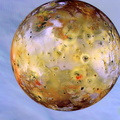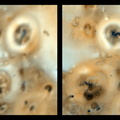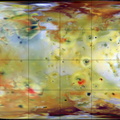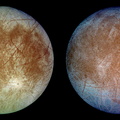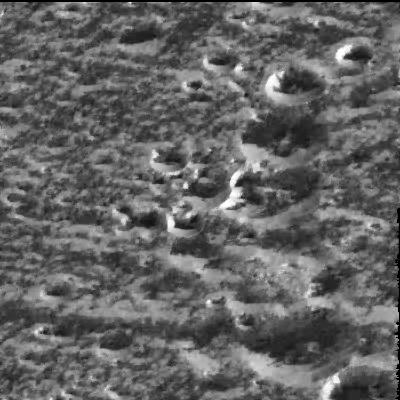
WIKIARCHIVES.SPACE
The Human Spaceflight Archive

Scientists believe that water-ice frosts are the likely cause for the brightening seen around the circular rims of these craters located at a high northern latitude (57 degrees) on Jupiter's moon Ganymede in this image taken by NASA's Galileo spacecraft on September 6, 1996. The image, just recently radioed to Earth from the spacecraft, shows the same kind of bright, high-latitude surface areas as those first seen by the Voyager spacecraft in 1979, but at higher resolution (this image spans about 18 kilometers or 11 miles on a side). Even though the Sun is shining from the south, the north-facing walls of the ridges and craters are brighter than the walls facing the Sun. This is interpreted to mean that the very bright north-facing slopes are covered with surface water-ice frosts, and that these frosts preferentially accumulate in such high-latitude locations. Galileo scientists say that at the high resolution seen in Galileo images, the high-latitude brightness seen by Voyager is partly attributable to frosts forming on cooler, north-facing slopes.
Information
- Taken in
- Author
- NASA/JPL-Caltech
- Description
-
Scientists believe that water-ice frosts are the likely cause for the brightening seen around the circular rims of these craters located at a high northern latitude (57 degrees) on Jupiter's moon Ganymede in this image taken by NASA's Galileo spacecraft on September 6, 1996. The image, just recently radioed to Earth from the spacecraft, shows the same kind of bright, high-latitude surface areas as those first seen by the Voyager spacecraft in 1979, but at higher resolution (this image spans about 18 kilometers or 11 miles on a side). Even though the Sun is shining from the south, the north-facing walls of the ridges and craters are brighter than the walls facing the Sun. This is interpreted to mean that the very bright north-facing slopes are covered with surface water-ice frosts, and that these frosts preferentially accumulate in such high-latitude locations. Galileo scientists say that at the high resolution seen in Galileo images, the high-latitude brightness seen by Voyager is partly attributable to frosts forming on cooler, north-facing slopes.
The right-hand side of the image is dominated by a north-south line of impact craters; the smallest ones at the top are about 2 kilometers (1.2 miles) in diameter and the large one at the bottom is about 5 kilometers (about 3 miles) in diameter. Ganymede is the largest moon in the solar system, larger than the planet Mercury and nearly the size of Mars.
- Created on
- Tuesday 18 November 1997
- Albums
- US SPACE PROGRAM / PROBES / JUPITER / GALILEO / Mission Photos (Edited) / JUPITER / GANYMEDE
- Source link
- https://photojournal.jpl.nasa.gov
- Visits
- 17
- Rating score
- no rate
- Rate this photo
- License
- Public Domain
- Modified by WikiArchives
- No (original)
- Downloads
- 0
Powered by Piwigo






